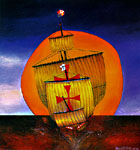 |
Our continued growth and focus on collections and exhibitions led to our name change in 1986. The OMA has since received numerous additional donations, and purchased works with the generous support of the local community. Our collection of late modernist paintings include works by Morris Louis and Jules Olitski; and our contemporary works include paintings by April Gornik, John Chamberlain, and sculpture by Malcolm Morley. Within the American collection is the contemporary American graphics collection which consists of 193 works by many of the most important artists of our time as well as artists who are now emerging into prominence. This collection includes prints by master artists such as Andy Warhol and Jasper Johns to more contemporary artists like Katherine Bowling and Jane Hammond. |



